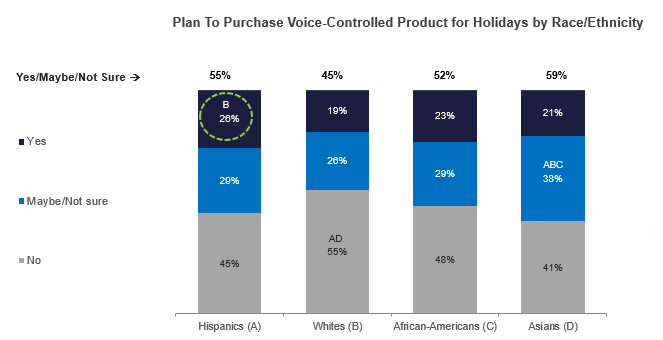OK Google, How Are Multicultural Consumers Adopting Smart Speaker Technology in the U.S.?
The demand for voice technology is sweeping across a digitally dependent consumer base. From Google Home to Amazon’s Alexa, smart speakers are popping up in homes across America, decorating countertops and end tables with sleek listening devices that stand ready to respond to the owner’s request. A recent study by Juniper Research finds that 55% of homes will have smart speakers by the year 2020. And as the quality of voice technology continues to improve, these numbers will most likely grow.
So, as a company dedicated to discovering cultural drivers, we asked ourselves, how does the adoption of home voice devices like smart speakers differ among multicultural consumers or does it stay the same?
To get answers, we asked a representative sample of U.S. Hispanics, African-Americans, Asians, and Whites various purchase related questions about home voice products in our recent ThinkNow Voice™ study. Our findings reveal that:
Consumers are warming up to the idea of smart speakers in their homes.
Roughly 30% of Total Market households have a voice-controlled smart speaker product:
Millennials, consumers ages 18-34, account for most of this early adoption. They are twice as likely to own a Google Home device compared to 35-64 year-olds:
But it’s important to note, the majority of consumers have yet to purchase a voice-controlled product for their home. And this could be for various reasons such as low awareness or fears of “eavesdropping” by the government. Whatever the reason, laggards represent a big opportunity for voice technology providers as well as the brands hoping to partner with them to reach consumers.
African-American and Asian consumers are driving smart speaker adoption.
African-Americans and Asians are the most likely to own a voice-controlled speaker product:
Hispanics are a close third, which is surprising considering Hispanics are considered “superconsumers” and are heavy users of digital media.
Smart speakers top the lists for many this holiday shopping season.
Savvy marketers will use the holiday shopping season to leverage consumers’ fear of missing out (FOMO) to increase sales. By targeting the 70% of consumers who’ve yet to purchase a voice-controlled product for their home, marketers have a chance to position smart speakers as a “must have” gift this holiday shopping season.
Of the four multicultural groups we surveyed, three expressed more interest in purchasing smart speakers for the holiday season compared to White consumers:
The final word on smart speaker technology is “just do it.”
- As reported, over 30% of the Total Market already own a smart speaker and even more are expected to purchase them for the holiday season. For brands looking to advertise on smart speakers, how can you make an impact without annoying your audience? Some consumers don’t want to hear ads over smart speakers, so exercise caution. In fact, some services, like Amazon, has nixed some forms of advertising from their platform entirely.
- Remember, smart speaker ownership is multicultural. African-Americans and Asians are leading smart speaker adoption. Hispanics are not too far behind. When putting together your strategy, be mindful of how different groups will engage with the technology. There’s no one size fits all approach here. Many ethnic groups within the U.S. have nomenclature that is unique to their culture. As always, a nuanced marketing approach works best.
- Don’t forget about Spanish-speakers. Voice provides a unique opportunity for marketers to connect with Spanish-dominant Latinos in the U.S. Google Home specifically has a robust Spanish language interface and voice enabled marketing can be a cost-effective alternative to television for brands looking to test the waters with Spanish-language marketing.
Download our detailed report here:



